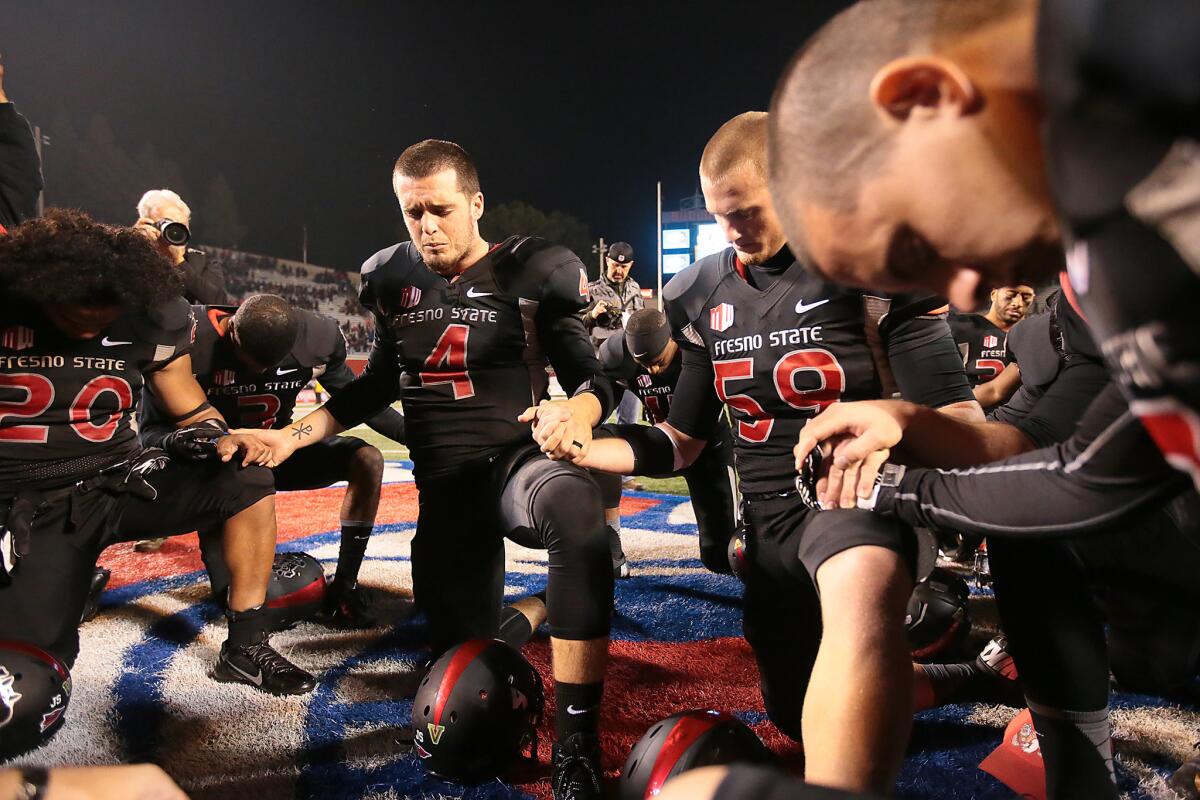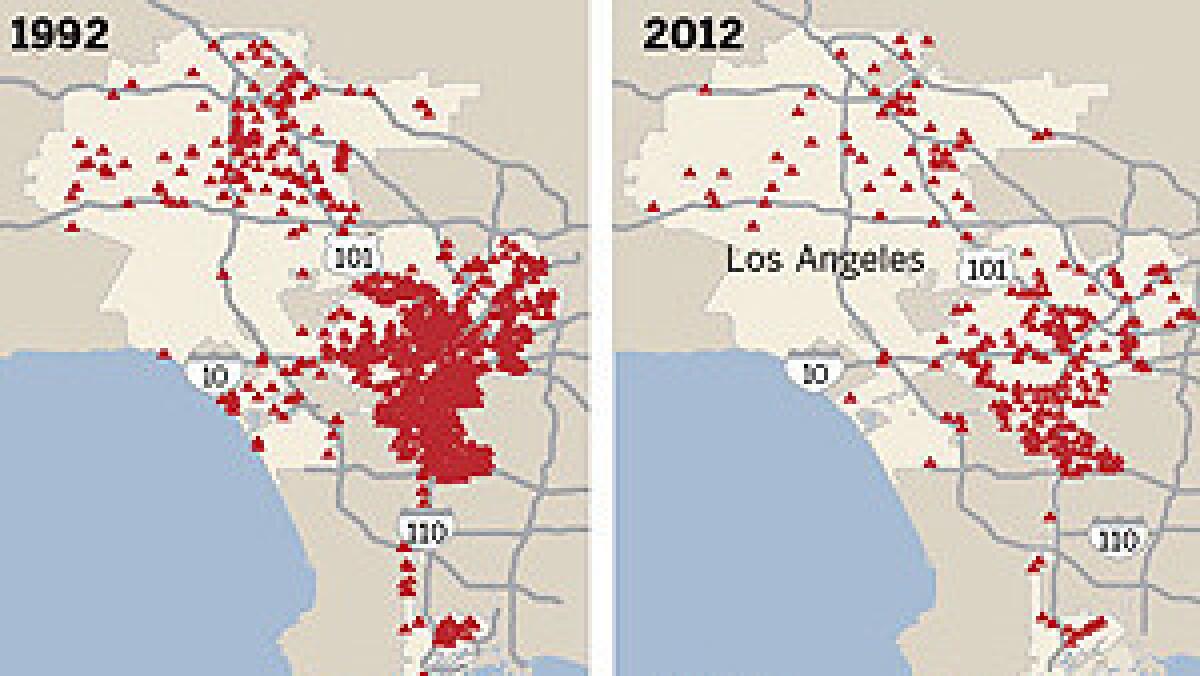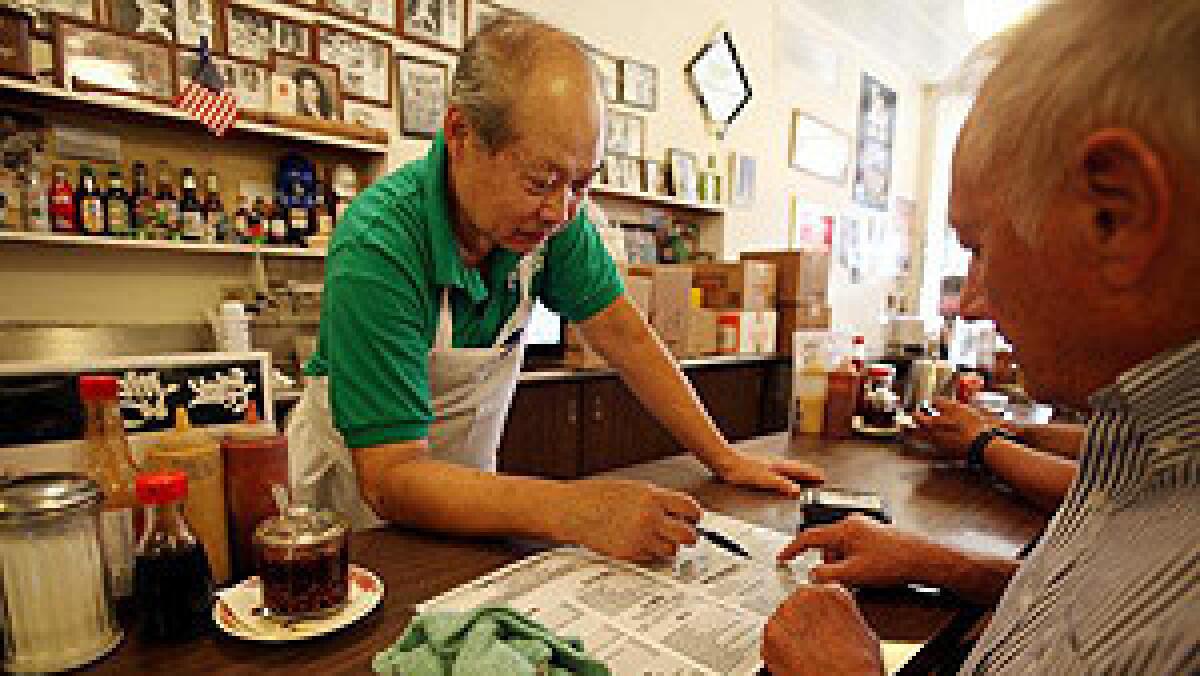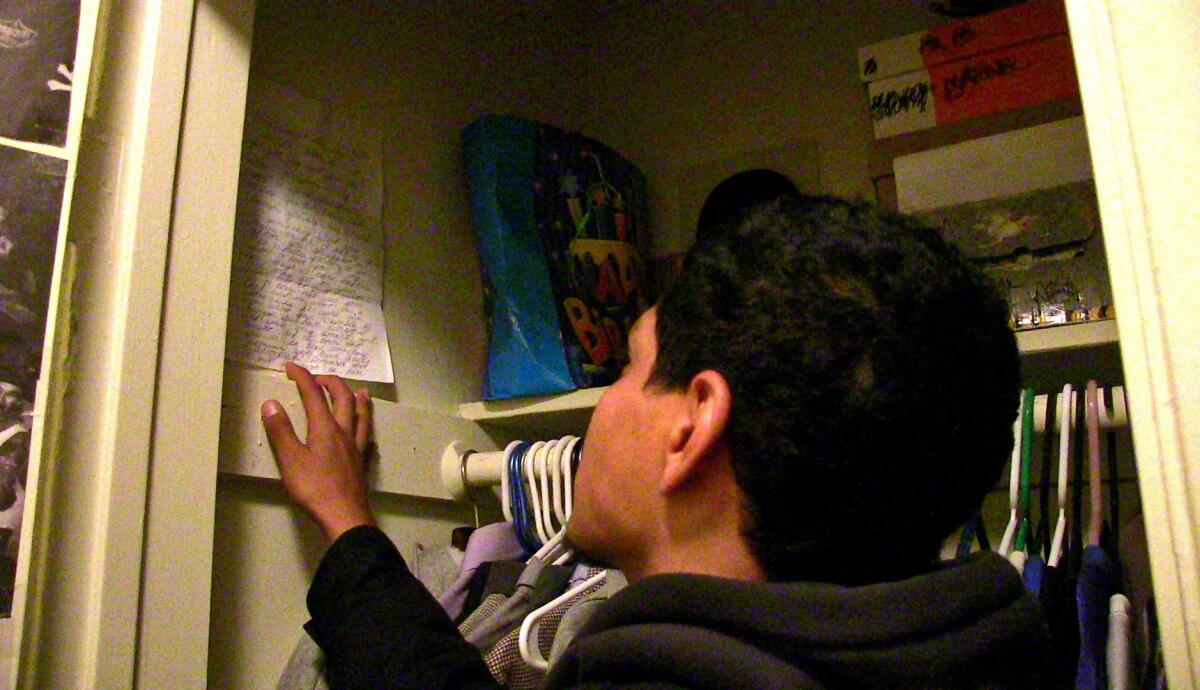Seems as if all of Fresno has adopted the Bulldogs
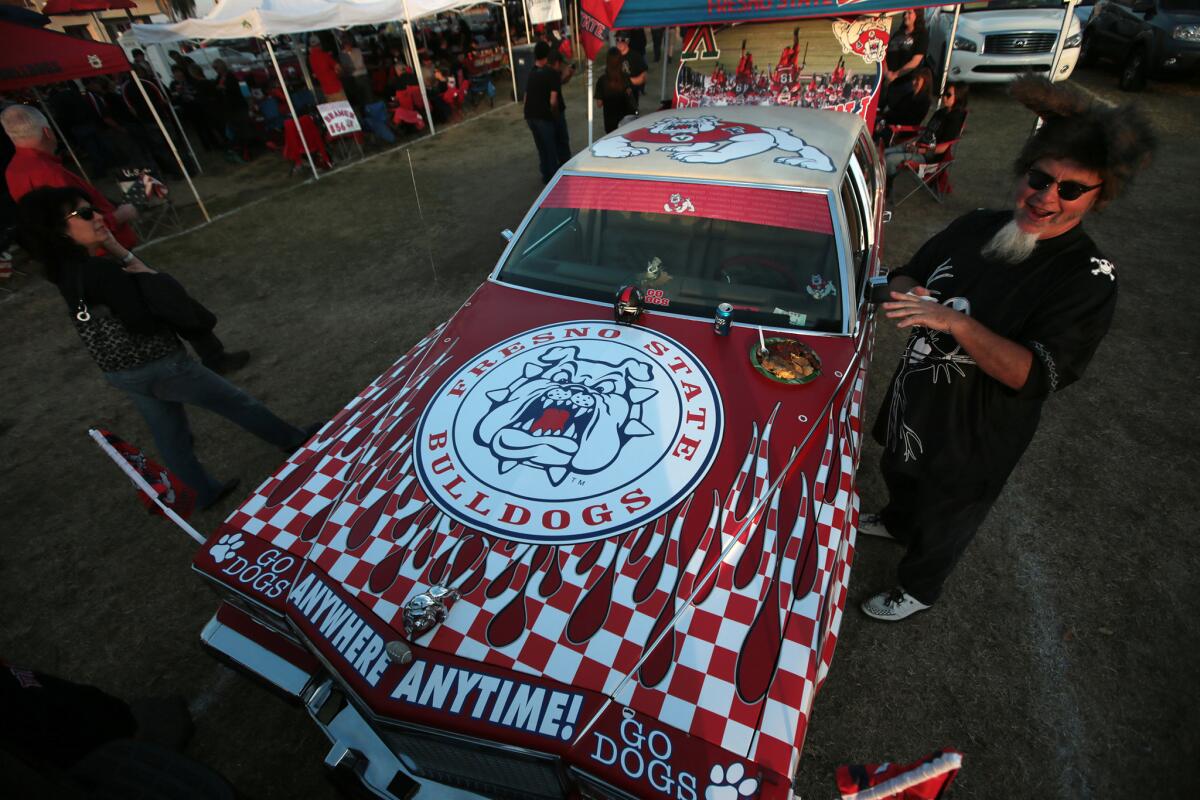
Fresno State’s football team is unbeaten and perhaps unmatched for fan pride among college teams in California.
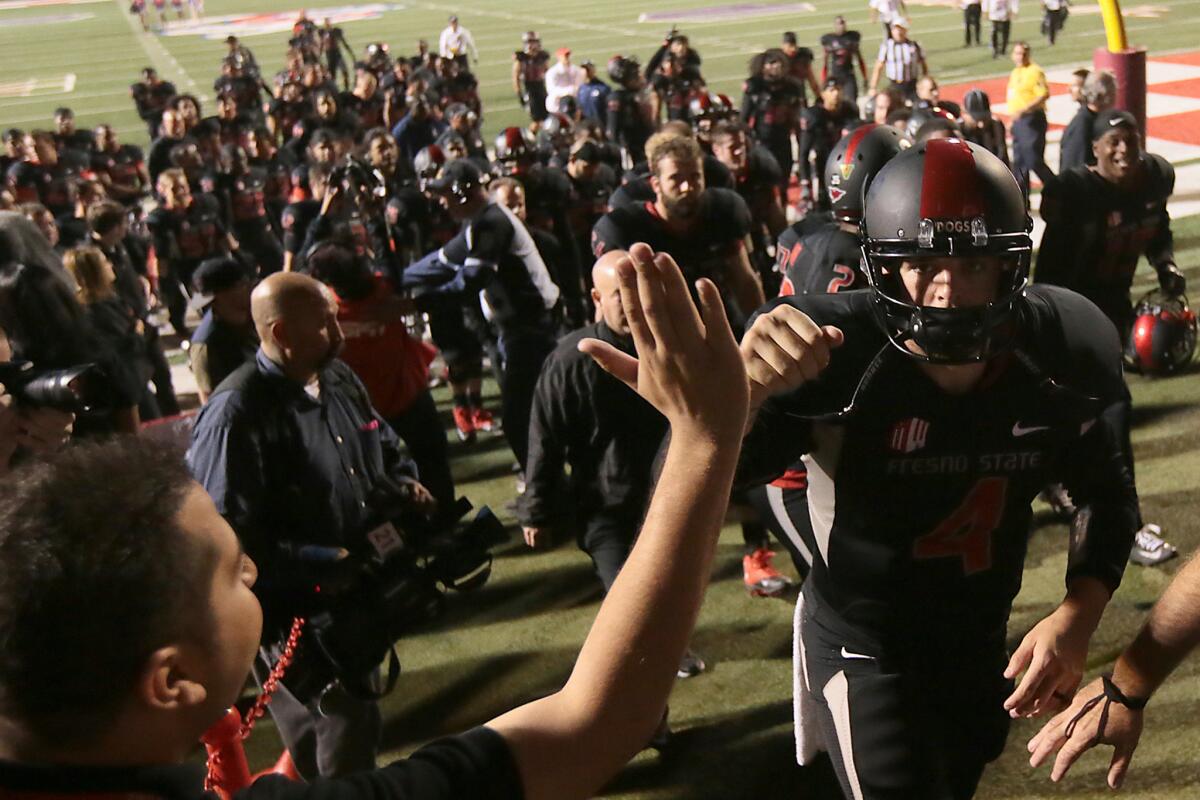
T
he flatbed trucks have backed onto the worn grass fields that ring Bulldog Stadium, which can mean only one thing: college football.
It's four days before Fresno State's next game, but preparations have begun. The trucks are packing aluminum frames and canvas, materials for the canopies that, come Saturday, will shelter the hundreds of pregame tailgate parties, the most elaborate of which feature live music and waiters serving prime rib and wine on white tablecloths.
At the Bulldog Shop, an apparel and souvenir store across the street from the stadium, customers clutch T-shirts, hoodies and mini football helmets in a long line headed toward the cash register. In the coming days, the store will set records for hourly, daily and weekly sales. At the other end of campus, inside the Dog House Grill, no one in the packed bar is playing much attention to flat screens showing highlights from far-away NBA and NHL games.
This is, after all, Bulldogs country, where college sports rules — most notably the undefeated, 15th-ranked Fresno State football team. Perhaps no team among California's scores of colleges energizes its hometown with as much passion and pride.
In the days before Halloween, Fresno is gearing up to host the University of Nevada Wolf Pack, a Mountain West Conference rival that has played in a bowl game in each of the last three seasons.
The electronic board above the door at the U.S. Mortgage Home Loan Center office sums up the community's support, flashing the message "Go Dogs."
On the day before the game, the Shaw Avenue shopping district is red with fans in Bulldogs hoodies and polo shirts. At Barry Maas' insurance company, everyone in the office either wears a shirt with a bulldog on it or spends the day avoiding cold stares from co-workers. Inside Dr. Eric Hanson's second-floor suite at the Sierra-Pacific Orthopaedic Center, nurses have large Bulldogs logos sewn onto the sleeves of their powder-blue smocks and the walls of the four examination rooms are covered with framed photos of the college's football players.
"The city shuts down for Bulldogs football," says Derek Carr, Fresno State's record-setting quarterback. "It's a big deal."
Carr would know. He no longer goes out for midweek dinners during the season because his meals were constantly interrupted by well-wishing fans.
When Fresno State played that home game against Nevada this month, the last ticket was sold five days before kickoff, marking the earliest sellout since the school's bowled stadium was expanded to 41,031 seats in 1991. It was the second full house in three home games for Fresno State, now 9-0 and expecting a capacity crowd for Saturday's final home game against New Mexico.
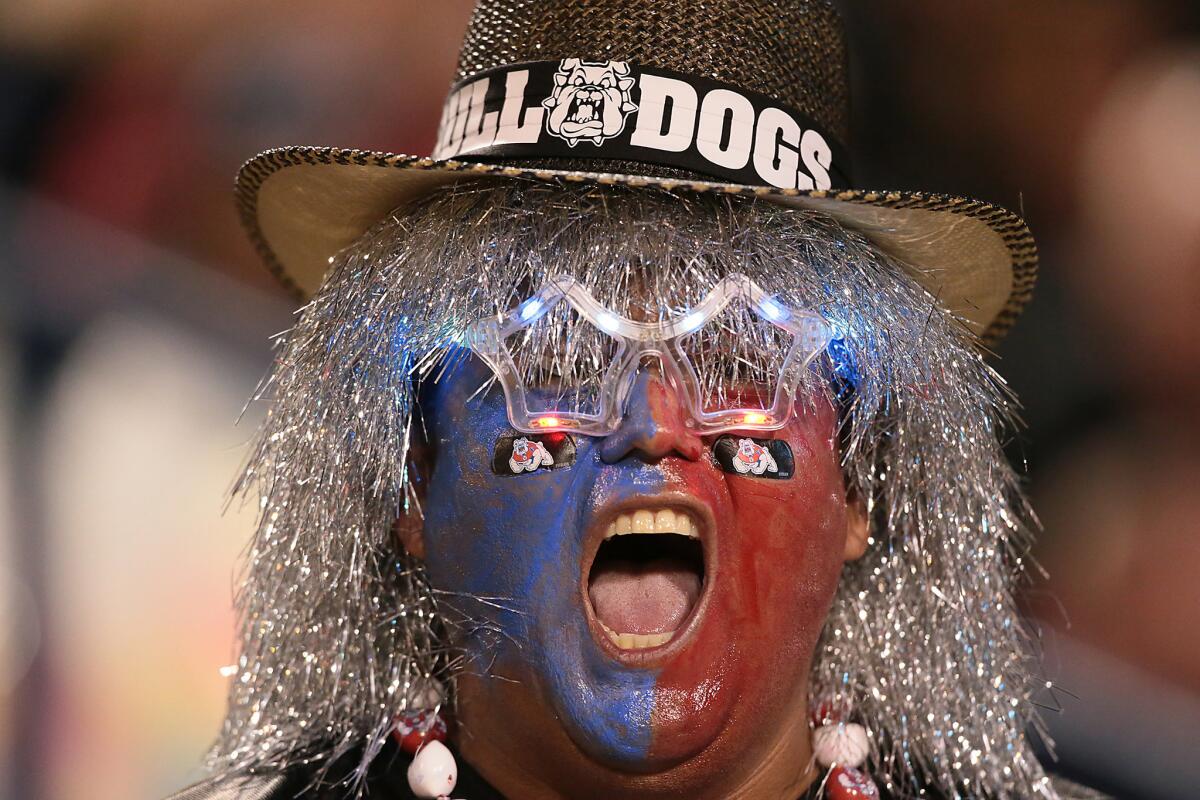
Flamboyant fan Johnny Hernandez cheers the Fresno State football team. More photos
Compare that with UCLA, which has a football team ranked a notch ahead of Fresno but hasn't filled its home stadium since 2006. USC sold out the Coliseum for Saturday's showdown with then-No. 5 Stanford, but earlier this season the Trojans were playing home games in a stadium barely half full.
The Coliseum and Pasadena's Rose Bowl, UCLA's home field, are substantially larger than Fresno State's stadium. But so is the population of L.A. County — nearly 10 million in 2012, compared with less than 1 million in Fresno County. And even when attendance swells for the Los Angeles teams, the atmosphere doesn't match that offered by this Central Valley city.
"This town's going nuts. I can't handle it, I'm so giddy," says Chris Pacheco, a former Fresno State player who, nearly three decades after his last game, still has the oversized body and booming personality of a defensive lineman.
When his playing days ended, Pacheco adopted a bulldog named Cal Bowl, one of the school's mascots. Running the dog around to promotional appearances led to connections that landed him a position in sales and marketing at KMJ-AM (580), which held the radio rights to Fresno State athletics for 43 years — until Pacheco bought his own station and paid $3 million to broadcast the Bulldogs' football games beginning this season.
Pacheco, who has a Fresno State logo affixed to the pool at his home in the city's tony Fig Garden neighborhood, cites football's ability to generate publicity as the reason people should "support it as much as we possibly can, and then support it some more."
Fresno fans turn out for more than football. Among California schools with women's basketball teams, only Stanford's national powerhouse drew larger crowds last season. And the Fresno State softball team has led the nation in average attendance 13 times since the NCAA began keeping track in 1991.
"As an athlete and a fan, it's pretty special," says Gena Strang-Behrens, a former Bulldogs softball player who is recognized around town 25 years after her last game. "The thing about Fresno is, we're a very large city but we still have that small-town feeling. San Francisco, L.A. are very different from our community."
When Fresno State's baseball team won the College World Series five years ago, about 12,000 fans waited up to two hours in nearly-100-degree heat to welcome the players and coaches home, lining a dusty and shadeless parade route that ended on campus.
Baseball Coach Mike Batesole, who left Cal State Northridge for the Bulldogs 11 years ago, calls Fresno "the last college town left in California." When he was hired, he had four young children who enjoyed dressing entirely in red and going to football and basketball games.
"Call me a goober, but I thought that was really cool," Batesole says. "It's what college athletics is supposed to be about."
Where else would the college bowling team — yes, Fresno has one — get local television coverage and a place of honor to hang its banner at the Dog House Grill?
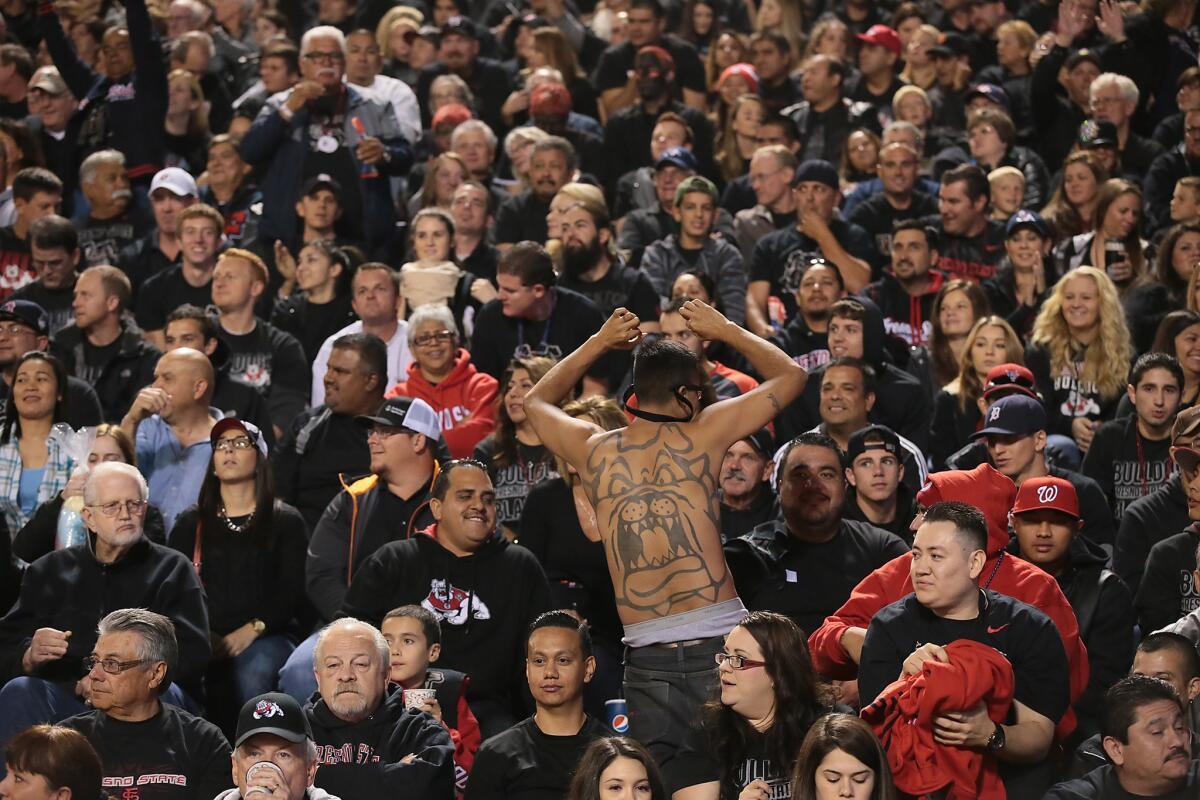
A shirtless fan shows off a bulldog tattoo as Fresno State plays Nevada at Bulldog Stadium. More photos
On football game day, the grass fields and parking lots next to the stadium are open to tailgaters about four hours before kickoff. Fresno State is primarily a commuter school, but for students lucky enough to live on campus Saturday night means they're about a quarter-mile walk from a very large party. And for them, admission is free.
The school allows fans to reserve a prime tailgate spot for between $150 and $600 per game, depending on size and location. Pacheco's radio station commands a huge area, erecting a giant white tent, covering the grass with bulldog-red carpet and pumping in air conditioning for his sponsors and guests. Others make do with a parking pass, a George Foreman grill and tattered lawn chairs.
At the fenced end of one lot, a band sets up on a stage as two firetrucks — lights and sirens blazing — cut through traffic ahead of two tour buses returning the team from a pregame meal. The players, dressed in black and red track suits, slowly make their way toward the locker room as the sound system blares the AC/DC rock anthem "T.N.T."
In a quieter area, Eric "Bill" Larson tends to a grill while occasionally handing out business cards with his self-proclaimed title: Director, Tailgate Operations. Close by is Brian Panish, Fresno State class of 1980, who is sitting on a folding chair at one of a dozen or so large picnic tables that have been squeezed under an awning next to the sports medicine building he helped fund.
The thing about Fresno is, we’re a very large city but we still have that small-town feeling."— Gina Barrows
Panish, who was born not far from L.A. City Hall, played football for Fresno State before becoming a personal injury attorney to the stars, representing such clients as Michael Jackson's family. Here, he's best known as one of the football program's generous donors, having given hundreds of thousands of dollars in recent years.
Panish lives in Los Angeles but flies in for Fresno State home games. He says variances in style and substance between rural Fresno, the center of the fertile San Joaquin Valley, and Southern California's suburban sprawl have helped deepen his connections to his alma mater.
"I really owe a lot to Fresno State. It made a huge difference in my life," Panish says. "In L.A. a lot of people have their own agenda. Here, people's No. 1 agenda is the Bulldogs, win or lose."
It is Blackout Night at the Nevada game, with most fans shedding their Bulldogs red for black, giving the aging concrete stadium an ominous feel. Add to that the deafening roar that erupts when Fresno State's black-clad team races onto the field through a massive inflatable bulldog, and it's easy to understand why Carr was able to burn the nervous Nevada defense for a 57-yard pass on the Bulldogs' first play from scrimmage.
Before halftime, Carr's 17-yard touchdown pass to Josh Harper gives the Bulldogs a 24-7 lead on their way to a 41-23 rout.

Brian Boever eats off the hood of his custom Cadillac as fans flock to Bulldog Stadium to tailgate and cheer the undefeated Fresno State football team. More photos
Afterward, as drivers maneuver around beer bottles, abandoned mini footballs and other detritus left behind by tailgaters, Brian Boever leans against his tricked-out, Bulldogs-red 1986 Cadillac Fleetwood Brougham. The car is covered with team logos and has a miniature Fresno State helmet bolted to the hood.
This is the second classic car Boever has had outfitted in Fresno State colors. The first, a 1981 Brougham, blew a gasket on the Grapevine heading to a game with USC, then lost its transmission on a road trip to Oregon a year later. He sticks with Cadillacs, he says, because "Bulldog Sentra doesn't sound right."
A general manager for a transportation company, Boever, 59, grew up in the shadows of the San Gabriel Mountains watching USC and UCLA. He switched allegiance to Fresno State when he moved here three decades ago.
He says Fresno State football allows him to forget about more serious things for a few hours. He suspects that is what ultimately draws people to support sports at a school based in an agricultural county that has more livestock and grapevines than people.
"You've got all the Regular Joe stuff to do during the week," Boever says. "But then you think, 'I can go down here and be like a kid again for a while.'"
Follow Kevin Baxter (@kbaxter11) on Twitter
Go beyond the scoreboard
Get the latest on L.A.'s teams in the daily Sports Report newsletter.
You may occasionally receive promotional content from the Los Angeles Times.
